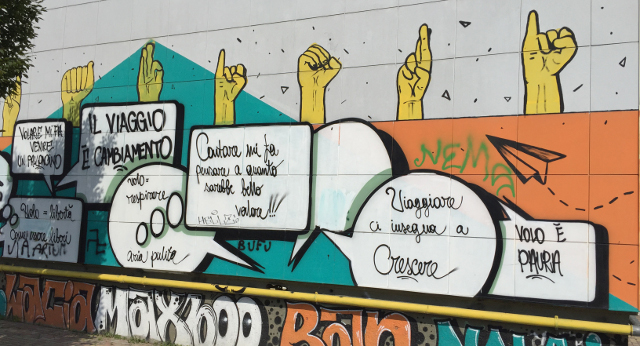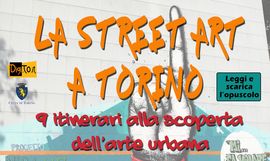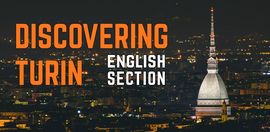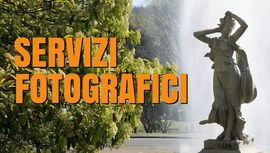Home » DISCOVERING TURIN » Guide to urban art: Mirafiori Sud
24 Settembre 2019
Guide to urban art: Mirafiori Sud
Our journey to discover Turin’s urban art continues with monuments dedicated to the Resistance, portraits of writers and mysterious metallic animals
Fabio Gusella (translation by Giulia Schimmenti)
After a first stop in the neighborhoods of Santa Rita and Mirafiori Nord and a second one in Barriera di Milano, the third destination of our tour in search of street art will be another ventricle of the industrial heart of Turin: we are talking about Mirafiori Sud, also depicted in the pictures of Francesca Vaglio Laurin. As in the past, also this time we have relied on the art historian Marzia Bolle, already co-author of the illustrated guide L’arte nelle strade di Torino (2017, Edizioni del Capricorno).
Starting from via Plava 30. Just beyond the entrance gate of the Fiat plant, we can find the sculpture Le due forze (The two forces). It was created at the end of the Seventies by Turin goldsmith and sculptor Bruno Martinazzi. The sculpture represents two huge fists made out of stone. As Bolle told us, the work was commissioned by Giovanni Agnelli and was also defined by Sergio Marchionne as a symbol of enterprises: “A synthesis of forces that converge towards the same goal”.
Crossing corso Unione Sovietica, we continue on via Arturo Farinelli and we end up in piazza Santi Apostoli. In the immediate vicinity, we find via Giovanni Verga. On a wall on the right, near the intersection with Strada delle Cacce, there is a series of graffiti, in the middle of which emerges one of the many works made by the cultural association of graffiti-writers Monkeys Evolution: Bolle told us that the mural (painted in 2010), was inspired by the most famous novel by Verga, I Malavoglia. Among the rebellious waves, there are a bottle and a mobile phone floating, both symbols of deeper meanings. A few steps further on, set in the frame of a stamp, there is a black and white portrait of the writer.
From via Verga we turned right to reach strada Castello di Mirafiori; we followed it until the crossroads with via Emanuele Artom and there, in the middle of the roundabout, there is the sculpture Due noci (Two nuts, 2010). The main subject of the sculptor Marcella Tisi – comments Bolle – is nature, with which she confronts herself in order to respect its authenticity and energy, and thus invites viewers to reflect on respect for the ephemeral balance that binds them to it. Her interventions are always based on the place that will host her works”.
We continued on in via Artom 81 where, on three apartment buildings, we can admire three collective murals built in 2017 for the Mira-Up project. As we learned from Bolle, “the first mural encourages the use of the bicycle to save nature from smog and concrete: a boy, riding his bike on a barbed wire leaves behind a dry tree and heads to another one still in bloom. On the second wall – she continues – there is a big hand that raises its index finger towards the sky, that is an invitation to look up and touch the sky with a finger. Finally, the third wall stimulates the viewer to escape from the greyness of the city towards the Journey, the knowledge … even of new languages, as evidenced by the nine painted hands, which in sign language have written the word ‘Mirafiori’.”
At the corner of via Artom and via Candiolo (near the civic library Cesare Pavese), there is a work that the young emerging artists Margherita Bobini and Andrea Gritti wanted to dedicate to the theme of the Resistance: it is a mural depicting Emanuele Artom, a young Jewish partisan who died in prison under torture in 1944. In this regard, Bolle told us to walk a little further on and go pay homage to the nearby memorial plaque of the young man, located at the corner between via Artom and via Onorato Vigliani.
Continuing along via Artom, on the left there is the sculpture Iguana: a metallic animal immersed in the green that the sculptor, designer and teacher Luigi Nervo created in 1982 using common painted metal tubes, then bent as to create a giant reptile or, in the words of Nervo, a “machine-game” designed to bring man closer to the environment in which it is placed. Through Bolle’s story, we also discover that the artist preferred to share the production of the work with a group of Fiat workers in redundancy fund, thus underlining his vocation towards social work.
At the end of via Artom, at one of the entrances to the Colonnetti Park, there is Monumento alla Pace (Peace Monument) by Alessandro Roncaglio. Behind this simple work, there is a terrible story: “It was just a few months before the Liberation – said Bolle – when the very young Alessandro is arrested and handed over to the Germans with his father: they are both deported first to Mauthausen and then to the extermination camp of Gusen II, where his father died.”
The monument in the Colonnetti Park, created by Roncaglio many years after the end of the war (in 1992), consists of a cantilevered stainless steel plate bearing phrases, symbols and drawings that recall and celebrate the values and the fallen of the Resistance. In the background of mountains, a partisan is depicted as he rests his rifle on the side of a mountain hut. Roncaglio himself stressed that “the partisan does not bury his rifle and does not hand it over, but hangs it, ready to defend again the values for which he fought”. As Bolle noted, stainless steel is a symbol of indestructibility, just like the values of the Resistance and the Constitution. “My works – declared the artist – do not belong to art in the strict sense, but claim public space as a place of collective memory“.
We learned that the Roncaglio family lived in the nearby via Onorato Vigliani 172. At its entrance there is a stone, set in the asphalt, dedicated to Alessandro’s father, Giovanni. Our visit ends here but, between one step and the next, we try to stumble: only in this way we won’t forget.
In collaboration with Study in Torino






